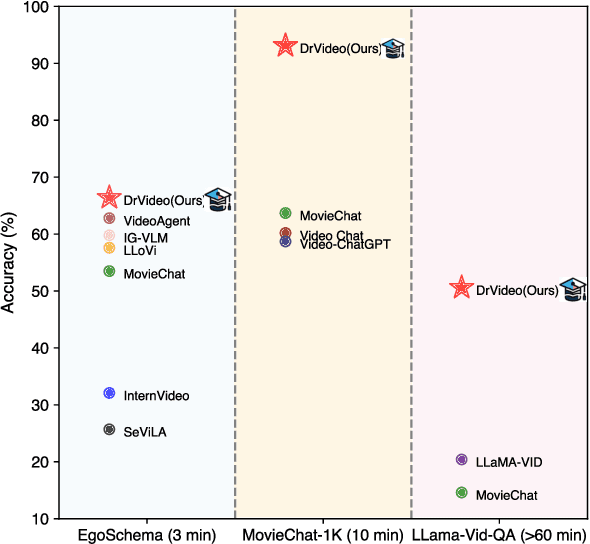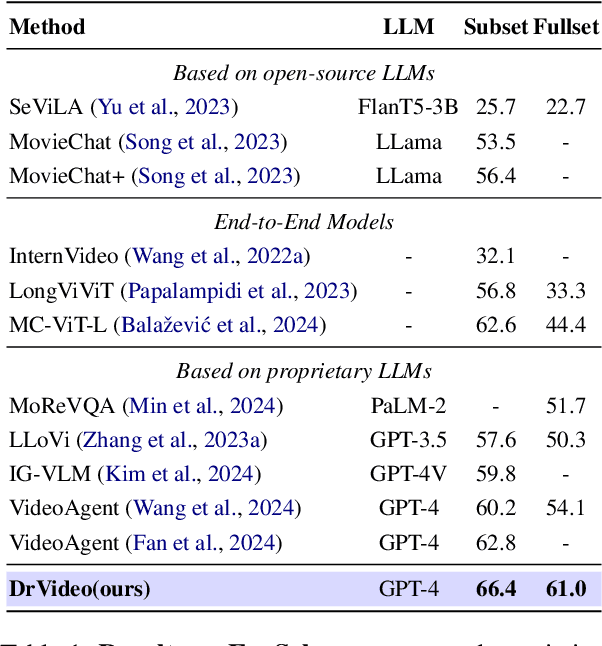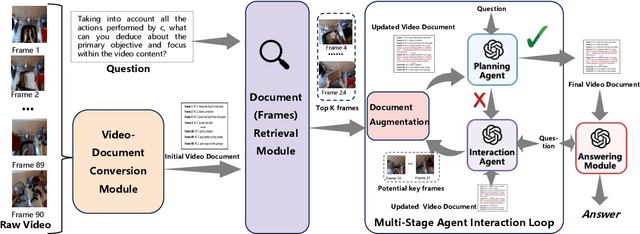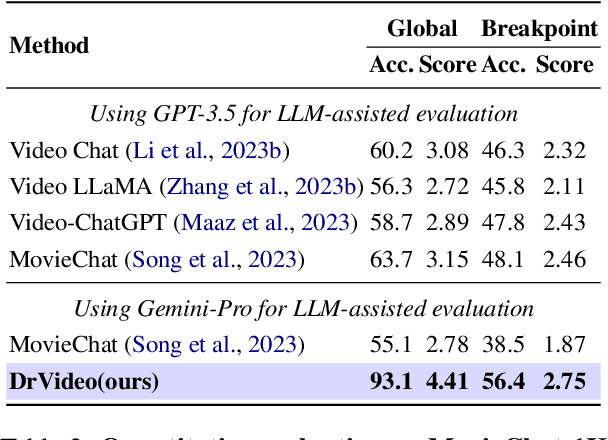Bin Sun
Member, IEEE
Multimodal Prompt Alignment for Facial Expression Recognition
Jun 26, 2025Abstract:Prompt learning has been widely adopted to efficiently adapt vision-language models (VLMs) like CLIP for various downstream tasks. Despite their success, current VLM-based facial expression recognition (FER) methods struggle to capture fine-grained textual-visual relationships, which are essential for distinguishing subtle differences between facial expressions. To address this challenge, we propose a multimodal prompt alignment framework for FER, called MPA-FER, that provides fine-grained semantic guidance to the learning process of prompted visual features, resulting in more precise and interpretable representations. Specifically, we introduce a multi-granularity hard prompt generation strategy that utilizes a large language model (LLM) like ChatGPT to generate detailed descriptions for each facial expression. The LLM-based external knowledge is injected into the soft prompts by minimizing the feature discrepancy between the soft prompts and the hard prompts. To preserve the generalization abilities of the pretrained CLIP model, our approach incorporates prototype-guided visual feature alignment, ensuring that the prompted visual features from the frozen image encoder align closely with class-specific prototypes. Additionally, we propose a cross-modal global-local alignment module that focuses on expression-relevant facial features, further improving the alignment between textual and visual features. Extensive experiments demonstrate our framework outperforms state-of-the-art methods on three FER benchmark datasets, while retaining the benefits of the pretrained model and minimizing computational costs.
FocalAD: Local Motion Planning for End-to-End Autonomous Driving
Jun 13, 2025Abstract:In end-to-end autonomous driving,the motion prediction plays a pivotal role in ego-vehicle planning. However, existing methods often rely on globally aggregated motion features, ignoring the fact that planning decisions are primarily influenced by a small number of locally interacting agents. Failing to attend to these critical local interactions can obscure potential risks and undermine planning reliability. In this work, we propose FocalAD, a novel end-to-end autonomous driving framework that focuses on critical local neighbors and refines planning by enhancing local motion representations. Specifically, FocalAD comprises two core modules: the Ego-Local-Agents Interactor (ELAI) and the Focal-Local-Agents Loss (FLA Loss). ELAI conducts a graph-based ego-centric interaction representation that captures motion dynamics with local neighbors to enhance both ego planning and agent motion queries. FLA Loss increases the weights of decision-critical neighboring agents, guiding the model to prioritize those more relevant to planning. Extensive experiments show that FocalAD outperforms existing state-of-the-art methods on the open-loop nuScenes datasets and closed-loop Bench2Drive benchmark. Notably, on the robustness-focused Adv-nuScenes dataset, FocalAD achieves even greater improvements, reducing the average colilision rate by 41.9% compared to DiffusionDrive and by 15.6% compared to SparseDrive.
NTIRE 2025 challenge on Text to Image Generation Model Quality Assessment
May 22, 2025Abstract:This paper reports on the NTIRE 2025 challenge on Text to Image (T2I) generation model quality assessment, which will be held in conjunction with the New Trends in Image Restoration and Enhancement Workshop (NTIRE) at CVPR 2025. The aim of this challenge is to address the fine-grained quality assessment of text-to-image generation models. This challenge evaluates text-to-image models from two aspects: image-text alignment and image structural distortion detection, and is divided into the alignment track and the structural track. The alignment track uses the EvalMuse-40K, which contains around 40K AI-Generated Images (AIGIs) generated by 20 popular generative models. The alignment track has a total of 371 registered participants. A total of 1,883 submissions are received in the development phase, and 507 submissions are received in the test phase. Finally, 12 participating teams submitted their models and fact sheets. The structure track uses the EvalMuse-Structure, which contains 10,000 AI-Generated Images (AIGIs) with corresponding structural distortion mask. A total of 211 participants have registered in the structure track. A total of 1155 submissions are received in the development phase, and 487 submissions are received in the test phase. Finally, 8 participating teams submitted their models and fact sheets. Almost all methods have achieved better results than baseline methods, and the winning methods in both tracks have demonstrated superior prediction performance on T2I model quality assessment.
Enhancing User-Oriented Proactivity in Open-Domain Dialogues with Critic Guidance
May 18, 2025Abstract:Open-domain dialogue systems aim to generate natural and engaging conversations, providing significant practical value in real applications such as social robotics and personal assistants. The advent of large language models (LLMs) has greatly advanced this field by improving context understanding and conversational fluency. However, existing LLM-based dialogue systems often fall short in proactively understanding the user's chatting preferences and guiding conversations toward user-centered topics. This lack of user-oriented proactivity can lead users to feel unappreciated, reducing their satisfaction and willingness to continue the conversation in human-computer interactions. To address this issue, we propose a User-oriented Proactive Chatbot (UPC) to enhance the user-oriented proactivity. Specifically, we first construct a critic to evaluate this proactivity inspired by the LLM-as-a-judge strategy. Given the scarcity of high-quality training data, we then employ the critic to guide dialogues between the chatbot and user agents, generating a corpus with enhanced user-oriented proactivity. To ensure the diversity of the user backgrounds, we introduce the ISCO-800, a diverse user background dataset for constructing user agents. Moreover, considering the communication difficulty varies among users, we propose an iterative curriculum learning method that trains the chatbot from easy-to-communicate users to more challenging ones, thereby gradually enhancing its performance. Experiments demonstrate that our proposed training method is applicable to different LLMs, improving user-oriented proactivity and attractiveness in open-domain dialogues.
Do Multimodal Language Models Really Understand Direction? A Benchmark for Compass Direction Reasoning
Dec 21, 2024



Abstract:Direction reasoning is essential for intelligent systems to understand the real world. While existing work focuses primarily on spatial reasoning, compass direction reasoning remains underexplored. To address this, we propose the Compass Direction Reasoning (CDR) benchmark, designed to evaluate the direction reasoning capabilities of multimodal language models (MLMs). CDR includes three types images to test spatial (up, down, left, right) and compass (north, south, east, west) directions. Our evaluation reveals that most MLMs struggle with direction reasoning, often performing at random guessing levels. Experiments show that training directly with CDR data yields limited improvements, as it requires an understanding of real-world physical rules. We explore the impact of mixdata and CoT fine-tuning methods, which significantly enhance MLM performance in compass direction reasoning by incorporating diverse data and step-by-step reasoning, improving the model's ability to understand direction relationships.
DrVideo: Document Retrieval Based Long Video Understanding
Jun 18, 2024



Abstract:Existing methods for long video understanding primarily focus on videos only lasting tens of seconds, with limited exploration of techniques for handling longer videos. The increased number of frames in longer videos presents two main challenges: difficulty in locating key information and performing long-range reasoning. Thus, we propose DrVideo, a document-retrieval-based system designed for long video understanding. Our key idea is to convert the long-video understanding problem into a long-document understanding task so as to effectively leverage the power of large language models. Specifically, DrVideo transforms a long video into a text-based long document to initially retrieve key frames and augment the information of these frames, which is used this as the system's starting point. It then employs an agent-based iterative loop to continuously search for missing information, augment relevant data, and provide final predictions in a chain-of-thought manner once sufficient question-related information is gathered. Extensive experiments on long video benchmarks confirm the effectiveness of our method. DrVideo outperforms existing state-of-the-art methods with +3.8 accuracy on EgoSchema benchmark (3 minutes), +17.9 in MovieChat-1K break mode, +38.0 in MovieChat-1K global mode (10 minutes), and +30.2 on the LLama-Vid QA dataset (over 60 minutes).
Dynamic Stochastic Decoding Strategy for Open-Domain Dialogue Generation
Jun 12, 2024



Abstract:Stochastic sampling strategies such as top-k and top-p have been widely used in dialogue generation task. However, as an open-domain chatting system, there will be two different conversation scenarios, i.e. chit-chat and knowledge-based question answering. In the former situation, responses diversity is essential due to the one-to-many nature in dialogue. The latter, on the other hand, requires less randomness given that stochastic decoding strategy entails the risk of generating incorrect information. As a result, an adaptive and flexible decoding strategy is needed to cope with these two scenarios simultaneously. To this end, we propose the dynamic decoding strategy (DDS), which can adjust the decoding space w.r.t. different contexts. In DDS, both sequence-level and token-level adaptive search can be achieved to adjust the decoding process in a unified framework. Besides, our adaptive algorithm can not only be used during model inference, but it can also be applied during the model training stage to further enhance the performance. Comprehensive experiments indicate that the proposed decoding strategy can consistently improve the performance of pre-trained dialogue models when coupled with four well-used stochastic decoding algorithms.
GeReA: Question-Aware Prompt Captions for Knowledge-based Visual Question Answering
Feb 04, 2024Abstract:Knowledge-based visual question answering (VQA) requires world knowledge beyond the image for accurate answer. Recently, instead of extra knowledge bases, a large language model (LLM) like GPT-3 is activated as an implicit knowledge engine to jointly acquire and reason the necessary knowledge for answering by converting images into textual information (e.g., captions and answer candidates). However, such conversion may introduce irrelevant information, which causes the LLM to misinterpret images and ignore visual details crucial for accurate knowledge. We argue that multimodal large language model (MLLM) is a better implicit knowledge engine than the LLM for its superior capability of visual understanding. Despite this, how to activate the capacity of MLLM as the implicit knowledge engine has not been explored yet. Therefore, we propose GeReA, a generate-reason framework that prompts a MLLM like InstructBLIP with question relevant vision and language information to generate knowledge-relevant descriptions and reasons those descriptions for knowledge-based VQA. Specifically, the question-relevant image regions and question-specific manual prompts are encoded in the MLLM to generate the knowledge relevant descriptions, referred to as question-aware prompt captions. After that, the question-aware prompt captions, image-question pair, and similar samples are sent into the multi-modal reasoning model to learn a joint knowledge-image-question representation for answer prediction. GeReA unlocks the use of MLLM as the implicit knowledge engine, surpassing all previous state-of-the-art methods on OK-VQA and A-OKVQA datasets, with test accuracies of 66.5% and 63.3% respectively. Our code will be released at https://github.com/Upper9527/GeReA.
Escape Sky-high Cost: Early-stopping Self-Consistency for Multi-step Reasoning
Jan 19, 2024Abstract:Self-consistency (SC) has been a widely used decoding strategy for chain-of-thought reasoning. Despite bringing significant performance improvements across a variety of multi-step reasoning tasks, it is a high-cost method that requires multiple sampling with the preset size. In this paper, we propose a simple and scalable sampling process, \textbf{E}arly-Stopping \textbf{S}elf-\textbf{C}onsistency (ESC), to greatly reduce the cost of SC without sacrificing performance. On this basis, one control scheme for ESC is further derivated to dynamically choose the performance-cost balance for different tasks and models. To demonstrate ESC's effectiveness, we conducted extensive experiments on three popular categories of reasoning tasks: arithmetic, commonsense and symbolic reasoning over language models with varying scales. The empirical results show that ESC reduces the average number of sampling of chain-of-thought reasoning by a significant margin on six benchmarks, including MATH (-33.8%), GSM8K (-80.1%), StrategyQA (-76.8%), CommonsenseQA (-78.5%), Coin Flip (-84.2%) and Last Letters (-67.4%), while attaining comparable performances.
Turning Dust into Gold: Distilling Complex Reasoning Capabilities from LLMs by Leveraging Negative Data
Dec 20, 2023



Abstract:Large Language Models (LLMs) have performed well on various reasoning tasks, but their inaccessibility and numerous parameters hinder wide application in practice. One promising way is distilling the reasoning ability from LLMs to small models by the generated chain-of-thought reasoning paths. In some cases, however, LLMs may produce incorrect reasoning chains, especially when facing complex mathematical problems. Previous studies only transfer knowledge from positive samples and drop the synthesized data with wrong answers. In this work, we illustrate the merit of negative data and propose a model specialization framework to distill LLMs with negative samples besides positive ones. The framework consists of three progressive steps, covering from training to inference stages, to absorb knowledge from negative data. We conduct extensive experiments across arithmetic reasoning tasks to demonstrate the role of negative data in distillation from LLM.
 Add to Chrome
Add to Chrome Add to Firefox
Add to Firefox Add to Edge
Add to Edge